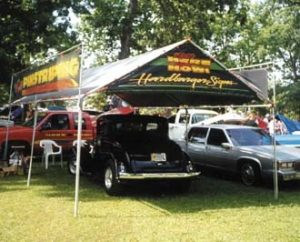Bob Hardbarger, Hardbarger Signs (Ellenboro, WV), has been making signs since 1963, when he was a junior in high school. He began attending vehicle shows in 1980 and entered the profession full-time in '83.
When he initially started the local show circuit, he'd just "show up at an event." He explains, "I'd take along a paint brush or two and a little paint and go to the show. I'd put my supplies in a little, red kids' wagon and walk 2-1/2 miles around the speedway of the Charlotte (NC) Auto Fair. I'd do two laps a day around the racetrack, and along the way, I'd stop and letter prices on windshields for people. I'd stay in a hotel, eat like a king and come home with $500 in my pocket."
These days, Hardbarger's approach is quite different. He sets up a sun-blocking canopy at shows, and clients come to him. Many local show promoters don't offer canopies as an option, so he owns one. Hardbarger says the tent helps cool a vehicle's surface, which makes painting easier. "I've paid my dues; I'm not going to be out in the sun anymore," he says.
Hardbarger also owns a 16-ft. trailer, complete with a computer and vinyl-cutting equipment, which he takes to truck lots for fleet work. However, he doesn't like to take his trailer to auto shows.
"When you have a computer at a car show, you need to hire three or four people to help you work because customers want to watch you design. They want to see all their font options, but you can't afford to allow them to look at everything because it takes too much time away from your work," he explains. "I'd rather paint because you can make more money in less time."
Many show promoters ask Hardbarger to attend their events. But novice painters don't receive personal invitations. As such, he recommends that neophytes seek local show advertisements in auto magazines and online.
Advertisement
Unlike Chaszeyka, Hardbarger prefers auto shows to bike shows. Specifically, he enjoys working shows featuring trucks, street rods or street machines (any automobile).
"At auto shows, I decorate some bikes. But to concentrate on bikes, you have to like motorcycles more than I do, and you have to like people that like motorcycles," he says.
Often, auto owners attend shows for graphics because they don't know anyone locally who paints. Hardbarger's diverse graphics attract clients.
"From West-Coast style graphics and pinstriping to splash and sponge work — I cover the whole nine yards," he says.
Hardbarger travels to a half-dozen shows a year, mostly two-day events. According to him, a one-day event — unless it's close — isn't worth it financially.
"I attend shows because I enjoy the people, the cars and what I do. For me, going to a car show is a nice break from my normal routine," he says.
Advertisement
But he agrees with Chaszeyka: Shows aren't easy money. "Customers are there waiting for me when I arrive. They even help me set up. And once I do, I work like a dog all day, from the time I wake up in the morning, until I quit at night."
Sometimes, work doesn't even stop at nightfall. The first time Hardbarger worked a Virginia Beach (VA) show, he learned this lesson the hard way.
"It was an early spring show, and I worked like a dog all day. As the day kept going by, the guy in the booth next to me didn't do anything. When I finished my last job, working under the headlights of a truck, he turned on lights he'd brought for his booth and finally got started," Hardbarger recalls. "He worked all night and probably made 10 times the money I did, because guys at the show would get to drinking and pay him a lot of money to put graphics on their cars. They'd set up a ring of lawn chairs around his booth and watch him work, and then they'd leave. So he ended up with not only a lot of money, but a collection of lawn chairs too. By the next year though, I had my canopy ready — complete with lights."


 Tip Sheet3 days ago
Tip Sheet3 days ago
 Business Management1 week ago
Business Management1 week ago
 Women in Signs2 weeks ago
Women in Signs2 weeks ago
 Real Deal4 days ago
Real Deal4 days ago
 Editor's Note1 week ago
Editor's Note1 week ago
 Line Time2 weeks ago
Line Time2 weeks ago
 Product Buying + Technology1 week ago
Product Buying + Technology1 week ago
 Women in Signs4 days ago
Women in Signs4 days ago
















